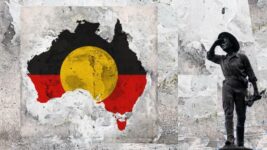The Doctrine of Discovery: The Church Legalised the European Colonial Project

UK Captain James Cook arrived on the east coast of the continent these days referred to as Australia in August 1770, and he claimed the island in the name of King George III, on the basis that it was terra nullius: “that no one owned the land prior to European assertion of sovereignty”.
This proclamation has always been troubling as over 500 different First Nations existed upon this continent at the time, with an estimated 750,000 people living within them.
But Cook’s assertion was backed up by the Doctrine of Discovery: a series of papal bulls, or decrees, made by the pope.
In the mid to late 15th century, European monarchies, such as the Spanish and Portuguese, had their eye on territorial expansion and creating a slave trade, so they petitioned the pope to issue a series of papal bulls between 1452 and 1493 that legitimised the now five century old colonial project.
The Discovery Doctrine sets out that European Christians were able to acquire lands that were deemed “empty”, even though Indigenous peoples lived there. And this was possible as the doctrine asserts non-Christians to be nonhumans and, therefore, unable to own the land on which they live.
So, according to the doctrine, discovery actually means found by European Christians.
Yet, despite the obvious questionable legal aspects to this doctrine of European racial superiority, its dictates continue to influence the laws and functioning of our settler colonial nation, and others like it, both at common and statutory law.
Enshrined in law
The 1823 US Supreme Court case Johnson versus M’Intosh saw US Chief Justice John Marshall invoking the Doctrine of Discovery as an authority to support his ruling, which continues to shape laws within English-speaking settler colonial nations, such as Canada and New Zealand.
Over the years 1773 through to 1775, Thomas Johnson, who later became a Supreme Court justice, bought tracts of land from the Piankeshaw Native American tribes in the area of what’s now southern Illinois. And when Johnson died in 1819, his interests in the land were passed on to his son.
But, in 1818, fur trader William M’Intosh purchased 11,000 acres of land from the US government, which was some of the same territory that Johnson had already bought.
So, Johnson’s descendants sought an ejection order against M’Intosh from the US District Court, but they lost their case.
On appeal, the Supreme Court upheld the original decision outlining that the Piankeshaw had no right to sell the land, as they didn’t own it, therefore Johnson’s chain of title was invalid.
Marshall further found that the colonising powers bestowed by the Discovery Doctrine had granted the government radical title.
This precedent has since been raised in numerous US cases, with the last being 2005’s City of Sherrill versus Oneida Indian Nation of New York, in which the Oneida people’s claim that they shouldn’t pay tax on the purchase of a parcel of their traditional lands didn’t hold due to Johnson.
Terra nullius
In 1835, the Port Phillip Association began settling the land in the vicinity of Melbourne following representative John Batman having established a treaty with Wurundjeri elders. Yet, British legal authorities later deemed this void, citing the precedent set by Johnson as the reasoning.
This finding then led NSW governor Richard Bourke to make an 1835 proclamation, which prohibited settlers from entering into treaties or land deals with First Nations people, as the land belonged to no one prior to the British Crown. And this established the doctrine of terra nullius in local law.
The 1889 UK Privy Council case Cooper versus Stuart involved a dispute over land that the colony of NSW wanted to reclaim from William Cooper, whose father was granted the land by the NSW governor-in-chief in 1823 on the proviso that the state may reacquire it from him in the future.
Prior to the court ruling against Cooper’s claim that “the rule against perpetuities” prevented NSW from taking back the land, it had to be established whether British law operated within the colony, and the court found that it had held since 1788, due to the doctrine of terra nullius.
On this matter, the Privy Council ruled that “at the time when it was peacefully annexed to the British dominions”, the land now bearing the name NSW was “a tract of territory practically unoccupied, without settled inhabitants or settled law”.
The 1992 High Court Mabo decision overturned the legal fiction of terra nullius, recognising that First Nations people have prior claim to the land. And this led to the passing of the Native Title Act 1993 (Cth), which created a process of establishing where native title exists.
But native title has been watered down over time. Initially, this was seen with the 1996 Wik decision of the High Court, which found that while native title can coexist with pastoral lease rights, when a conflict of interest exists, the leaseholder’s rights always prevail, and native title is extinguished.
Mere assumption
In similar ways to that in Australia, the Doctrine of Discovery and the Johnson precedent continue to influence Canadian law.
During the 2020 Demystifying the Doctrine of Discovery forum, Canadian Law Professor John Borrows spoke about the doctrine assuming the inferiority of Indigenous peoples and its basis in the understanding that the pope’s jurisdiction covered all people across the globe.
A member of the Chippewas of the Nawash First Nation, Borrows discussed how the Doctrine of Discovery continues to inform decisions being made in Canadian courts, and he pointed to the 1997 Canadian Supreme Court case Delgamuukw v The Queen as being particularly problematic.
“Aboriginal title is a burden on the Crown’s underlying title,” the Supreme Court judges set out in Delgamuukw. “The Crown, however, did not gain this title until it asserted sovereignty and it makes no sense to speak of a burden on the underlying title before that title existed.”
“Aboriginal title crystallised at the time sovereignty was asserted,” the judges determined.
However, Borrows questions how, in finding that the existence of Aboriginal title doesn’t make sense before the Crown asserted its sovereignty, the Supreme Court then solves this inconsistency via an unexplained process of crystallisation.
The scholar adds that the Crown claims to land are merely assumed “without any foundation” and with no connection to the “facts on the ground”.
Abolish the doctrine
“The Doctrine of Discovery had been used for centuries to expropriate Indigenous lands and facilitate their transfer to colonising or dominating nations,” the UN Permanent Forum on Indigenous Issues outlined in 2012.
The forum’s theme that year was the enduring impact of the Doctrine of Discovery, with attending Indigenous delegates asserting that the continuing influence of the pope’s decrees need to be understood and then dismantled.
The provisions of articles 28 and 37 in the UN Declaration on the Rights of Indigenous Peoples were raised, which recognise Indigenous people’s right to redress and compensation due to their occupied lands, as well as their rights to treaty and other constructive arrangements with the state.
For its part, the central governing body of the Catholic Church, the Holy See, stated in 2010, that the Church has had “no value” in the doctrine “whatsoever for centuries”, so if juridical systems continue to employ it as a precedent its “therefore now a characteristic of the laws of those states”.
In addressing the UN Permanent Forum in 2012, then Native Title Council of Australia executive officer the late Brian Wyatt called on the Human Rights Council universal periodic review process to take into the consideration how the doctrine continues to influence and take steps to redress it.
And Wyatt further stated that the legal justification for colonising Australia was “confused”, that the impact of the doctrine has devastated Aboriginal and Torres Strait Islander peoples, and he called for a raising of awareness around the severity of their marginalisation.






